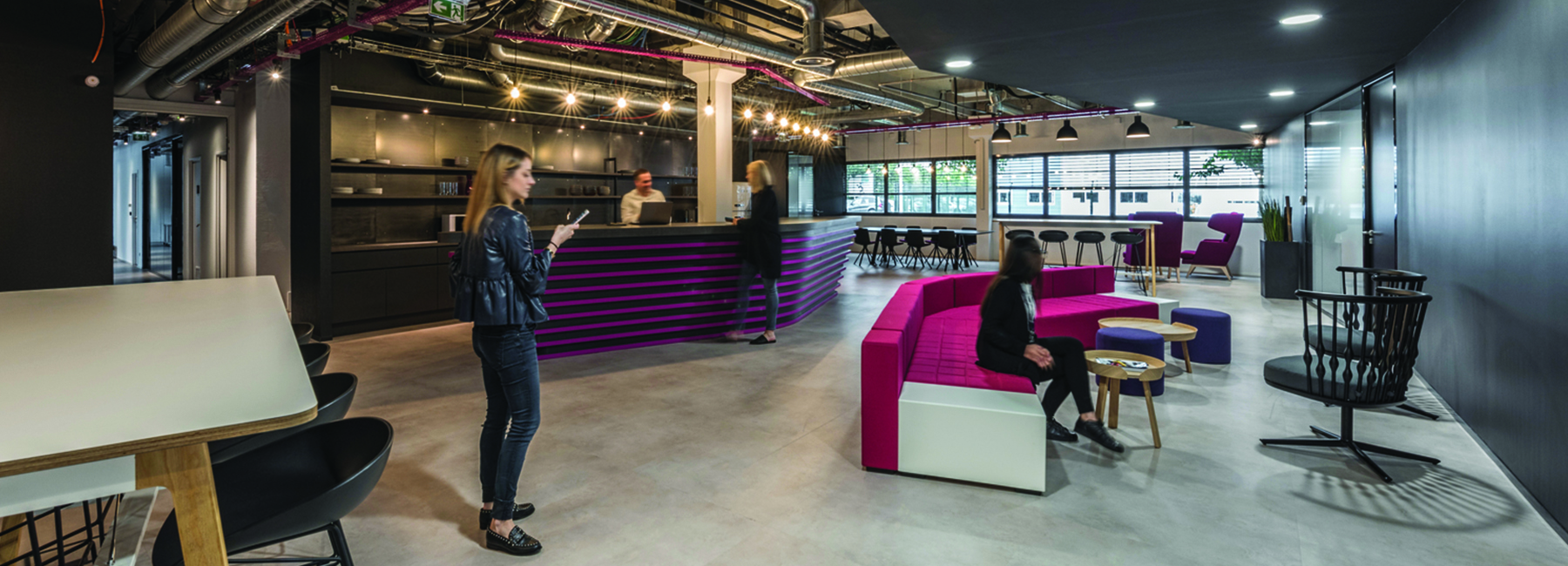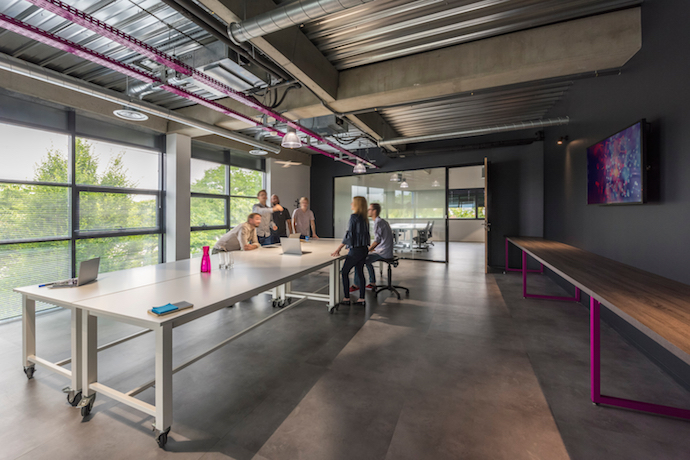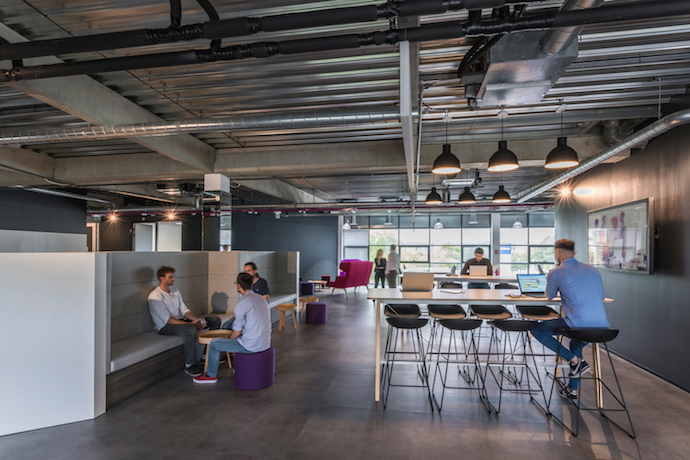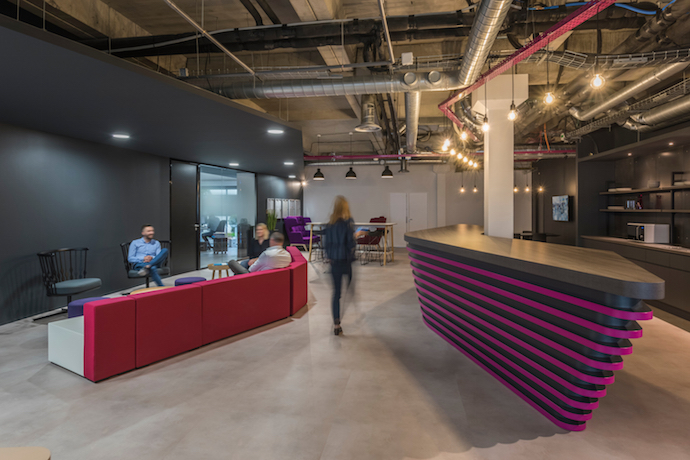Airbus Gets New Agile Spaces Designed to Accelerate Technology Development
Unispace, a workplace design expert, designed an agile concurrent design facility for aerospace giant Airbus in the South of France. To do this, Unispace converted an under-utilized building, located within Airbus’ wider headquarters campus at Toulouse Blagnac. The new workplace is designed to help research and technology specialists expedite solutions more rapidly by facilitating problem-solving in a concurrent rather than linear way. Across, four different spaces, this building, which they’ve called “Le Garage”–nodding to those Silicon Valley tech firms, such as Apple and Google, which got their start in California garages–has been created to encourage new ways of working. “The main goal for the space was to facilitate the concept of accelerated technology development,” said Max Lishmund, principal, design and Unispace design lead on the project. “And, despite the name, it is very different from an atypical Silicon Valley garage!”

When was the project completed?
2017
How much space?
31,755 SF
Was this new or renovated space?
Renovated
What is average daily population?
Flexible, between 15- 100
Is there a mobile work or work from home policy? If so, what percent of employees are remote workers?
The space is a flexible space for project teams to use across a variety of different development tasks.
Describe workspace types.
Workshop garages, sit-stand workstations, team benching, concurrent design facility studios. This is not an average office space. Our intention with Le Garage is to immerse our tech talent in a flexible, dynamic, open space that breaks down silos and hierarchical notions of seniority.”
The project garages are flexible and have the capability to adapt from desk based workspaces into physical workshop spaces. The wider agile space consists of varying open plan work zones–both dedicated and unassigned–town hall seating areas with writeable wall surfaces and integrated TV screens, smaller meeting and quiet rooms for touch down or focused work, as well as a boardroom for larger conferencing. The spaces are also supported by two tea points and collaborative breakout areas.

What kind of meeting spaces are provided?
Flexible, open meeting cafes are provided for informal connections and meetings, concurrent technical design rooms are used for technological meeting/workshops and more standard meeting spaces for team brainstorming.
What other kind of support space or amenity spaces are provided?
Welfare facilities, and flexible rooms for testing of prototypes. A central café amenity on each floor provides a front-facing space for visitors and third-party collaborators to drop-in and contribute to the projects that are active in the space.
What is the projects location and proximity to public transportation and/or other amenities?
The project location is Building D42 within the huge Toulouse campus for Airbus.
Was the C-suite involved in the project planning and design process? If so, how?
We presented, consulted and discussed the concept and design of the facility with Airbus’ Chief Technology Officer.
What kind of programming or visioning activities were used?
We used 3D visualizations of the space.

Were any pre-planning surveys conducted to get employee input?
The project brief was not about employee input. It was about accelerating innovation and design of aeronautical technologies by providing an entirely flexible project ‘garage’ for innovators within the Airbus Group. They were to use the space for a six-month period to interrogate an idea with Airbus’ investment and research backing to develop the project.
Were there any other kind of employee engagement activities?
We researched and assessed the types of project Airbus is involved in; the type of third party visitors and collaborators the staff may need to work with; and how they may be able to ‘dip in’ to the research facility. A lot of the research for these projects is founded on screen based software working and also physical prototyping in a workshop setting.
Were any change management initiatives employed?
This is not a project for change of the working styles. It is a project to support the innovation within the business and introduce external expertise to relevant projects. The innovation teams will take the space temporarily to research and develop their particular technology or concept.

Please describe any program requirements that were unique or required any special research or design requirements.
Concurrent Design Facilities are specialist spaces that support a large team of experts working across the same project and allowing them to make design decisions quickly and easily: It allows big teams to work productively within the same environment. We enjoyed researching the CDF function and finessing it within the Airbus project, to ensure extensive collaboration and drive business outcomes.
Was there any emphasis or requirements on programming for health and wellbeing initiatives for employees?
Health and wellbeing is a natural consideration in the design, and the spaces needed to be relaxing with many refreshment facilities on hand.
Were there any special or unusual construction materials or techniques employed in the project?
Flexible folding walls, and large-format screen display walls were an unique part of the design.
The aesthetic of the workplace design supports the notion of the garage environment: design meets engineering. Blending an industrial feel with angular joinery and modular furniture, the space is also wrapped in dark timber, highlighted by vibrant colour and pendant lighting selections. Lighting layout also enhances various zones within the space to echo the angular theme.
What were the major furniture products used?
Kinnarps workstations and seating

What kind of branding elements were incorporated into the design?
Because of the specialist nature of the space, and the multiple uses of the campus, the manifestation of the Airbus is kept to a minimum. Instead, we believe, it is tied up in the innovative use of space and its unique business purpose.
What is the most unique feature of the new space?
The CDF room itself and the central café connecting the project garages.
Are there any furnishings or spaces specifically included to promote wellness/wellbeing?
The state-of-the-art building accommodates more than 130 staff, including specialists in areas such as data science, applied mathematics, and electro-magnetics. There is also space for 40 visiting specialists from universities, start-ups and suppliers to Airbus. The Café area has been designed as a hub to bring these different areas of expertise together to collaborate, communicate and create.
What kind of technology products were used?
The design of Le Garage, comprises a central collaboration space: a hub supporting the various ‘project garages’ surrounding within the wider space – from concurrent on-screen technology development – where specialists work together on software capable of speeding-up design decisions and virtual prototypes – to more hands-on physical modeling and prototyping workshop spaces for new technologies.
There are offices for full-time staff but also large and small areas housing different sized project teams as well as an area filled with the latest digital technology dedicated to computer-aided design. This latter area is called the Concurrent Design Facility (CDF), a state-of-the-art space equipped with a network of computers, multimedia devices and software tools.
The CDF allows teams of experts from different disciplines to work collaboratively on design studies using concurrent engineering methodology for complex engineering systems.
“Instead of communicating across the large campus, the new spaces are designed to be booked out for periods of time for new innovations so they can be developed faster and with concentrated team collaboration,” explained Max Lishmund. “These agile spaces need to adapt quickly depending on the project requirements and the unique process the teams need to undergo in order to discover solutions.

If the company relocated to new space, what was the most difficult aspect of the change for the employees?
The transition from a heavily cellular space into a shared, collaborative environment.
How did the company communicate about the changes and moves?
Workshops were held with the users and regular updates given via their internal website.



